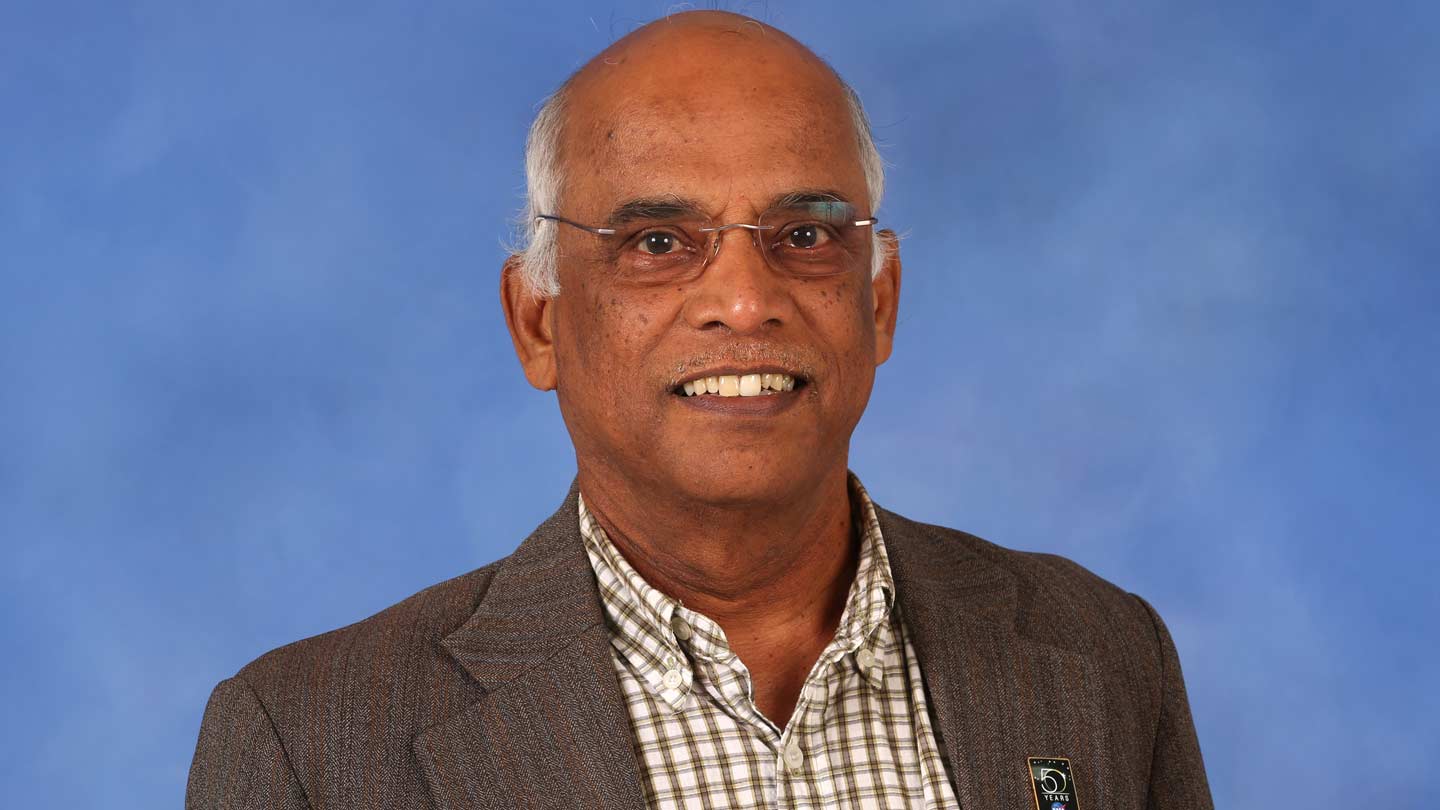
CSPAR research scientist Narayana Bhat will receive a Golden Eagle Award on Sept. 20.
Michael Mercier | UAH
NASA’s Marshall Space Flight Center (MSFC) has announced it will present a Golden Eagle Award to Dr. Narayana Bhat, a research scientist at The University of Alabama in Huntsville (UAH) Center for Space Plasma and Astronomic Research (CSPAR).
Dr. Bhat will receive the honor along with two others, Bill Cleveland and Lisa Gibby. All three are contractors on the team for NASA’s Fermi Gamma-ray Space Telescope and its Gamma-ray Burst Monitor (GBM).
The Golden Eagle award, part of Marshall's broader Mission Success is in Our Hands initiative, aims to strengthen team members’ commitment to mission assurance and flight safety. The awards will be presented Sept. 20.
"The award is for quickly restoring GBM to operations after GBM was turned off when the Fermi Spacecraft had an anomaly," says Dr. Michael Briggs, a CSPAR principal research scientist and Dr. Bhat’s supervisor. "The spacecraft-level anomaly was a problem with one of its solar arrays."
NASA reported the failure of a mechanism that drives one Fermi solar panel, an event that triggered an automatic "safe hold" that powered down Fermi’s instruments. Researchers at the National Space Science Technology Center (NSSTC) on the UAH campus sprang into action.
"We needed to do a series of commands to reboot and bring the experiment back to life," Dr. Bhat says.
"We maintain a test detector system here in our GBM Instrument Operation Center (GIOC) in NSSTC with electronics and the data processing system identical to the flight instrument," he says. "Every command we issue to the flight instrument is tested on the ground using the test system and the result of each command is recorded to ensure that it is what is expected."
The Spacecraft/Simulator Interface System (SIIS) in the test system was not communicating with the ground computer as expected, and without a working testing platform the flight instrument could not be turned on. When a reserve ground-based SIIS hardware system also failed, that created a crisis.
"I decided to spend time on the system with an idea to find a method to revive the SIIS," Dr. Bhat says. He is the only member of the GBM team who had extensive experience with the GBM hardware system, since he performed extensive testing before its launch in 2008.
"While I was trying different ideas, Bill Cleveland joined me, and he had some other suggestion to reprogram the computer on the SIIS," Dr. Bhat says. "We worked on it and the idea succeeded in making the SIIS communicate with the ground computer."
As the GBM operations manager, Gibby was responsible for working with the senior leadership of the GBM team to determine starting point settings for the GBM instrument. She then developed the commanding script that would restore GBM to the settings it had prior to shutdown.
"Bill Cleveland, GBM’s software engineer, was instrumental in bringing the GBM lab equipment back up," Gibby says. "We had a failure with one piece of lab equipment that the team was already working on prior to shutdown."
The next step was testing the script in the lab.
"Dr. Bhat and I tested the script of commands in the mode that they would be run on the flight unit. We made a couple of adjustments to the script, documented it and then had it approved by the principal investigator, Dr. Colleen Wilson-Hodge, prior to its use., Gibby says. "Stephen Elrod, the GBM project manager, and I monitored the execution of the commands when run on the flight unit."
As a result, the NSSTC researchers were able to make the standby SIIS work and use the test bed to test all their commands and reboot the onboard GBM experiment.
"The consequence of the quick and hard work of Narayana and the other awardees was that GBM returned to operation sooner, so that GBM would miss observations for as little time as possible," Dr. Briggs says.
Quickly returning the GBM to operation was important, says Dr. Gary Zank, CSPAR director and chair of UAH’s Department of Space Science.
"Gamma ray bursts, despite their inherent extraordinary energy, are extremely short-lived events, making the need for continuous reliable coverage by the spacecraft essential. And of course, no one knows when the most significantly remarkable event might occur next," says Dr. Zank. "So the importance of Dr. Bhat’s work and efforts cannot be overstated. This is an example of the kind of dedication exhibited by the GBM team on a daily basis."
Dr. Bhat says the work he does is itself a reward.
"Any additional reward, if any, is more like an icing on the cake," he says. "The most exciting aspect of my work with GBM is that our extensive testing of the entire GBM hardware along with its firmware and the flight software resulted in a fully functional experiment today, even after 10 years of operation. Each and every design element is functioning today as it was tested to be."
Because of its reliability, Dr. Bhat says GBM was able to obtain outstanding scientific results like the recent detection of an electromagnetic counter-part of a Gravitational Wave event detected by the LIGO experiment.